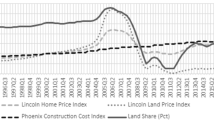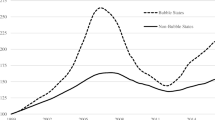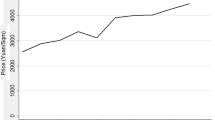Abstract
In this article, we build a simple present-value model to give the basis for an income-capitalization appraisal method considering interneighborhood dependency of net operating incomes. We also show the maximum-likelihood estimation method for the model in a cross-sectional situation and apply them to the residential land market in the Tokyo Metropolitan Area in the period 1986 to 1998. The results partly provide realistic estimates of the parameters and show the applicability of our model.
Similar content being viewed by others
References
Anselin, L. (1988a). “Lagrange Multiplier Test Diagnostics for Spatial Dependence and Spatial Heterogeneity,” Geographical Analysis 20, 1–17.
Anselin, L. (1988b). Spatial Econometrics: Methods and Models. Dordrecht: Kluwer.
Appraisal Institute (1996). The Appraisal of Real Estate (11th ed.). Illinois: Appraisal Institute.
Can, A. (1990). “The Measurement of Neighborhood Dynamics in Urban House Prices,” Economic Geography 66, 254–272.
Can, A. (1992). “Specification and Estimation of Hedonic Housing Price Models,” Regional Science and Urban Economics 22, 453–474.
Can, A., and I. Megbolugbe. (1997). “Spatial Dependence and House Price Index Construction,” Journal of Real Estate Finance and Economics 14, 203–222.
Cressie, N. A. C. (1993). Statistics for Spatial Data (2nd ed.). New York: Wiley.
Huang, J. S. (1984). “The Autoregressive Moving Average Model for Spatial Analysis.” Australian Journal of Statistics 26, 169–178.
Kanemoto, Y. (1990). “Tax Effects on Supply of Residential Land and Land Prices,” In K. Nishimura and Y. Miwa (eds.), Nihon no Kabuka Chika (The Japanese Stock Price and Land Price). Tokyo: University of Tokyo Press (in Japanese).
Kanou, S., and H. Murase. (1999). “On Land Price Formation: Bubble Versus Option,” Japanese Economic Review 50(2), 212–226.
Nishimura, K. (1995). Nihon no Chika no Kimarikata (The Factors That Determine Japanese Land Prices). Tokyo: Chikuma Shoten (in Japanese).
Pace, R. K., R. Barry, and C. F. Sirmans. (1998). “Spatial Statistics and Real Estate,” Journal of Real Estate Finance and Economics 17(1), 5–13.
Rao, C. R. (1973). Linear Statistical Inference and Its Applications (2nd ed). New York: Wiley.
Takatsuka, H. (1998). “A Present Value Model with Interdependence of Profits: Estimation of Spatio-Temporal Structure of Land Rents,” Ph.D dissertation, Tokyo Institute of Technology (in Japanese).
Takatsuka, H. (1999). “Applicability of Spatial Autoregressive Moving Average Model,” Kagawa University Economic Review 71(4), 253–277.
Takatsuka, H., and Y. Higuchi. (1995). “A Statistical Study of Spatial Relationship of Land Prices with Spatial Autocorrelation Analysis,” Studies in Regional Science 26(1), 139–153 (in Japanese).
Author information
Authors and Affiliations
Rights and permissions
About this article
Cite this article
Takatsuka, H., Higuchi, Y. A Present-Value Model of Real Estate with Interneighborhood Dependency of Incomes. The Journal of Real Estate Finance and Economics 23, 47–76 (2001). https://doi.org/10.1023/A:1011164723857
Issue Date:
DOI: https://doi.org/10.1023/A:1011164723857




